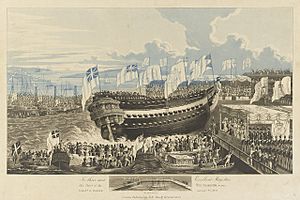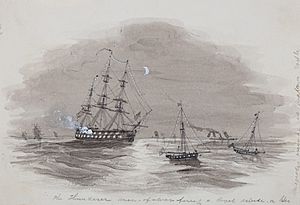HMS Thunderer (1831) facts for kids

Thunderer launched at Woolwich on 22 September 1831 (with inset a view of the New Basin)
|
|
Quick facts for kids History |
|
|---|---|
| Name | HMS Thunderer |
| Ordered | 23 January 1817 |
| Builder | Woolwich Dockyard |
| Laid down | April 1823 |
| Launched | 22 September 1831 |
| Renamed |
|
| Fate | Sold to be broken up, 1901 |
| Notes | Hulked, 1863 |
| General characteristics | |
| Class and type | Canopus-class ship of the line |
| Tons burthen | 2255 bm |
| Length | 193 ft 10 in (59.08 m) (gundeck) |
| Beam | 52 ft 4.5 in (15.964 m) |
| Depth of hold | 22 ft 6 in (6.86 m) |
| Propulsion | Sails |
| Sail plan | Full-rigged ship |
| Complement | 700 officers and men |
| Armament |
|

HMS Thunderer was a powerful sailing warship. She was a "ship of the line" with 84 guns. This means she was one of the biggest and strongest ships of her time.
She was built for the Royal Navy in the United Kingdom. Thunderer was launched on September 22, 1831. This happened at the Woolwich Dockyard, a famous shipbuilding place.
Contents
What Was a Ship of the Line?
A ship of the line was a large warship built between the 17th and mid-19th centuries. These ships were designed to fight in a "line of battle." This was a naval tactic where ships formed a line to fire their cannons at enemy ships.
Thunderer's Design
Thunderer was a modified version of the Canopus/Formidable-class ships. These ships were known for their strong build. They had two main decks where cannons were placed.
Ship's Size and Power
Thunderer was quite large for her time. She was about 193 feet long. Her main power came from her 84 guns. These included heavy 32-pounder cannons and smaller 24-pounder cannons. She also carried powerful carronades, which were shorter, lighter cannons.
Life of HMS Thunderer
Thunderer served the Royal Navy for many years. She was a symbol of British naval power. Her job was to protect trade routes and defend the country.
Later Years and Renaming
By 1863, Thunderer was no longer needed as an active warship. She was then "hulked," meaning she became a stationary ship. She was used as a target ship for training at Portsmouth.
In 1869, her name was changed to Comet. Just a year later, in 1870, she was renamed again to Nettle.
End of Service
HMS Nettle was eventually sold in December 1901. She was bought by a company called Messrs. King & Co. They broke her up for parts. This was the end of a long career for this historic ship.

